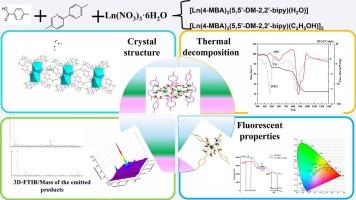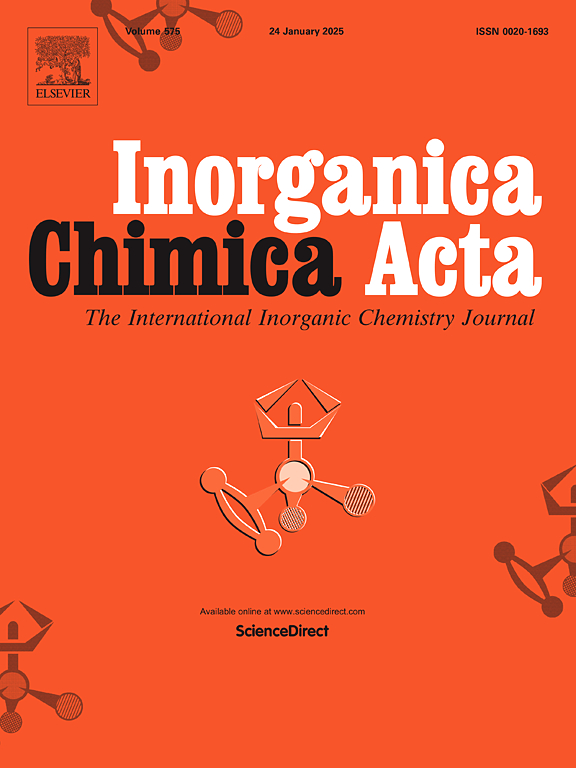Rare-earth metal complexes with 4-methylbenzoic acid and 5,5′-dimethyl-2,2′-bipyridine: crystal structures, thermal behavior, luminescence, and DFT analysis
IF 3.2
3区 化学
Q2 CHEMISTRY, INORGANIC & NUCLEAR
引用次数: 0
Abstract
This article reports six new rare-earth complexes formed by coordinating 4-methylbenzoic acid combined with 5,5′-dimethyl-2,2′-bipyridine with six rare-earth metal ions (Dy, Ho, Er, La, Ce, Nd,). X-ray diffraction analysis of single crystals revealed two distinct structural types of complexes: the Dy, Ho, and Er complexes exhibit mononuclear structures, while the La, Ce, and Nd complexes form dinuclear structures. FT-IR and Raman spectra were employed to analyze the chemical bonds and vibrational modes of the complexes in detail, confirming the coordination between the ligands and metal ions. X-ray diffraction (XRD) further verified the crystal structures of the complexes and provided information on their unit cell parameters and space groups. The thermal decomposition behavior and pyrolysis products of six complexes were systematically analyzed by TG-DTG-DSC/FTIR/GC–MS combined methods. Furthermore, together with density functional theory (DFT) computations, the mechanism of energy migration from ligands towards rare-earth ions was elucidated, and the luminescence properties of the Dy3+ complex was examined. The results indicate that these complexes undergo multi-stage decomposition and release characteristic gas products when heated. Additionally, the luminescence characteristics of the Dy complex were explored: when excited by ultraviolet light, the complex displays unique Dy3+ emission bands at the specific wavelengths of 480 nm and 575 nm, and they are respectively attributed to the energy - level transitions of 4F₉/₂ → 6H₁₅/₂ and 4F₉/₂ → 6H₁₃/₂.

稀土金属与4-甲基苯甲酸和5,5 ' -二甲基-2,2 ' -联吡啶配合物:晶体结构、热行为、发光和DFT分析
本文报道了由4-甲基苯甲酸与5,5′-二甲基-2,2′-联吡啶与6种稀土金属离子(Dy, Ho, Er, La, Ce, Nd,)配位形成的6种新型稀土配合物。单晶x射线衍射分析显示配合物有两种不同的结构类型:Dy、Ho和Er配合物为单核结构,而La、Ce和Nd配合物为双核结构。利用FT-IR和拉曼光谱对配合物的化学键和振动模式进行了详细分析,证实了配合体与金属离子的配位。x射线衍射(XRD)进一步验证了配合物的晶体结构,并提供了其单位胞参数和空间基团的信息。采用TG-DTG-DSC/FTIR/ GC-MS联合分析了6种配合物的热分解行为和热解产物。此外,结合密度泛函理论(DFT)计算,阐明了能量从配体向稀土离子迁移的机理,并对Dy3+配合物的发光特性进行了研究。结果表明,这些配合物经过多阶段分解,并在加热时释放出特征气体产物。此外,还探索了Dy配合物的发光特性:当被紫外光激发时,该配合物在480 nm和575 nm的特定波长处显示出独特的Dy3+发射带,它们分别归因于4F₉/₂→6H₁₅/₂和4F₉/₂→6H₁₃/₂的能级跃迁。
本文章由计算机程序翻译,如有差异,请以英文原文为准。
求助全文
约1分钟内获得全文
求助全文
来源期刊

Inorganica Chimica Acta
化学-无机化学与核化学
CiteScore
6.00
自引率
3.60%
发文量
440
审稿时长
35 days
期刊介绍:
Inorganica Chimica Acta is an established international forum for all aspects of advanced Inorganic Chemistry. Original papers of high scientific level and interest are published in the form of Articles and Reviews.
Topics covered include:
• chemistry of the main group elements and the d- and f-block metals, including the synthesis, characterization and reactivity of coordination, organometallic, biomimetic, supramolecular coordination compounds, including associated computational studies;
• synthesis, physico-chemical properties, applications of molecule-based nano-scaled clusters and nanomaterials designed using the principles of coordination chemistry, as well as coordination polymers (CPs), metal-organic frameworks (MOFs), metal-organic polyhedra (MPOs);
• reaction mechanisms and physico-chemical investigations computational studies of metalloenzymes and their models;
• applications of inorganic compounds, metallodrugs and molecule-based materials.
Papers composed primarily of structural reports will typically not be considered for publication.
 求助内容:
求助内容: 应助结果提醒方式:
应助结果提醒方式:


